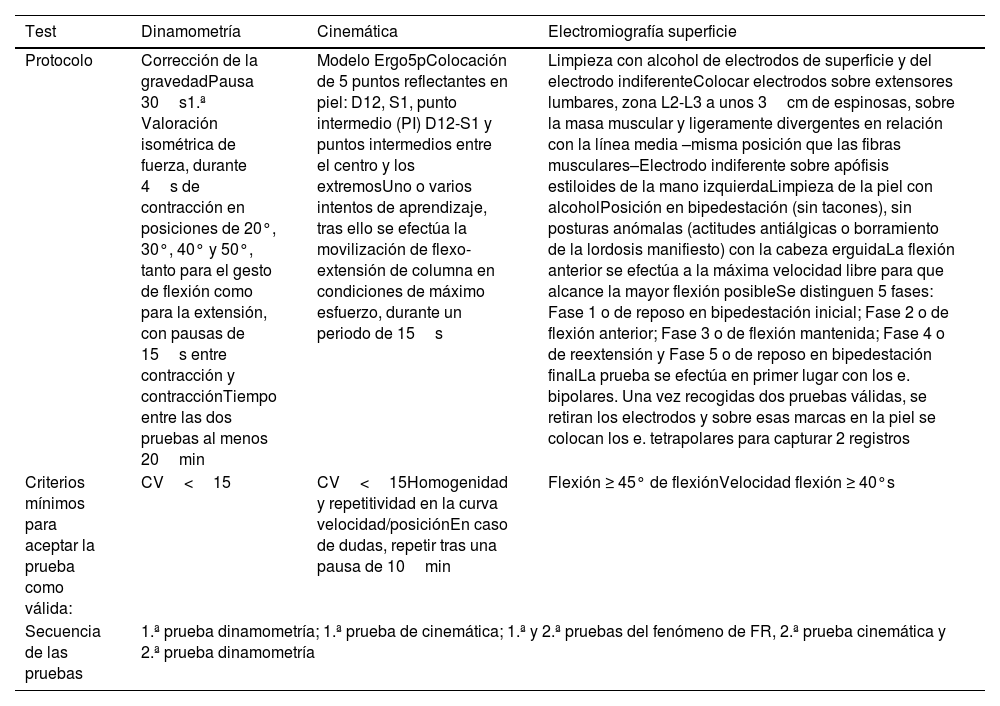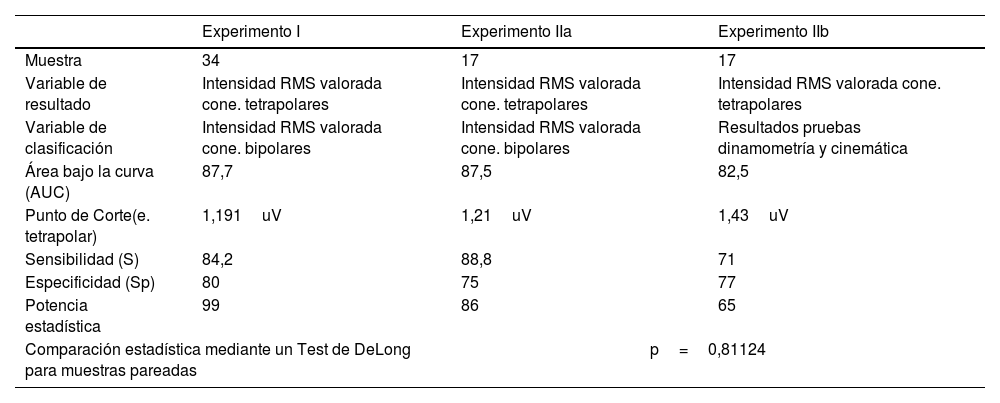Obtener un nuevo punto de corte (PC) para un test de flexión-relajación (FR) lumbar efectuado con electrodos (e.) tetrapolares, desde valores ya definidos con dispositivos bipolares.
Materiales y métodosLa muestra del estudio consta de 47 pacientes en situación de incapacidad temporal por dolor lumbar (DL). Fueron evaluados mediante un test de dinamometría isométrica, una prueba cinemática y una valoración del fenómeno FR.
Se plantean dos experimentos con curvas ROC. El primero, con 47 pacientes que efectuaron de modo consecutivo el test FR con ambos tipos de electrodos, utilizándose como variable de clasificación el punto de corte conocido para los e. bipolares (2,49uV). En el segundo, con los datos de la EMGs registrados con e. tetrapolares en 17 pacientes, se efectúa un test de DeLong que compara las 2 curvas ROC que construimos, por un lado, al clasificar la muestra desde pruebas de dinamometría y cinemática, y por el otro, al clasificarlos con los valores de la EMGs bipolar.
ResultadosUn total de 34 pacientes completaron adecuadamente las valoraciones del primer experimento y 17 pacientes el segundo. El primer estudio arroja un punto de corte de 1,2uV, con un AUC del 87,7%; sensibilidad 84,2% y especificidad 80%. El segundo muestra un PC para los e. bipolares de 1,21uV (AUC 87,5%) y para los e. tetrapolares de 1,43 (AUC 82,5%) con un test de DeLong sin diferencias significativas entre ambas curvas (p>0,4065).
ConclusionesLa metodología de validación con curvas ROC ha permitido obtener un nuevo PC para la prueba FR de modo práctico, simplemente simultaneando ambos test sobre el mismo grupo de pacientes hasta obtener una muestra significativa.
To obtain a new cut-off point (CP) for a lumbar flexion-relaxation (RF) test established with tetrapolar (e.) electrodes, from values already defined with bipolar devices.
Materials and methodsThe study sample consists of 47 patients in a situation of temporary disability due to low back pain (DL). They were evaluated by means of an isometric dynamometry test, a kinematic test and an assessment of the FR phenomenon.
Two experiments with ROC curves are proposed. The first, with 47 patients who consecutively performed the RF test with both types of electrodes, using the cut-off point (CP) known for the e. bipolar (2.49μV). In the second, with the EMG data recorded with e. tetrapolar in 17 patients, a DeLong test was performed that compares the 2 ROC curves that were constructed on the one hand, by classifying the sample from dynamometry and kinematic tests, and on the other, by classifying them with the bipolar EMG values.
ResultsA total of 34 patients adequately completed the evaluations of the first experiment and 17 patients the second. The first study shows a cut-off point of 1.2μV, with an AUC of 87.7%; Sensitivity 84.2% and Specificity 80%. The second shows a PC for e. bipolars of 1.21μV (AUC 87.5%) and for e. tetrapolar values of 1.43 (AUC 82.5%) with a DeLong test without significant differences between both curves (p>0.4065).
ConclusionsThe validation methodology with ROC curves has made it possible to obtain a new PC for the RF test in a practical way, simply by simultaneously performing both tests on the same group of patients until a significant sample is obtained.














